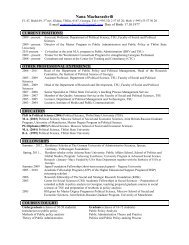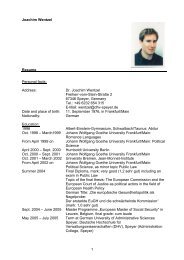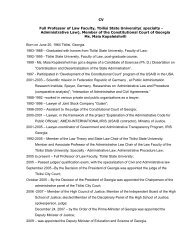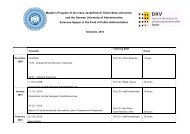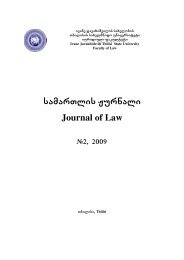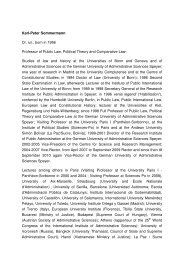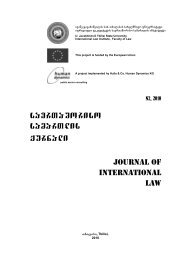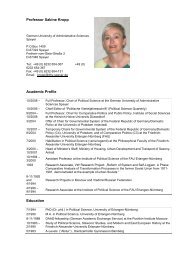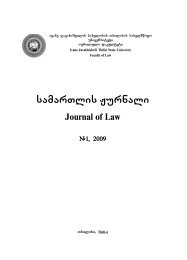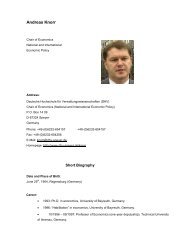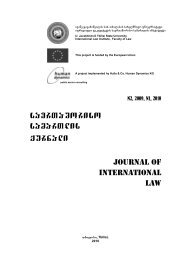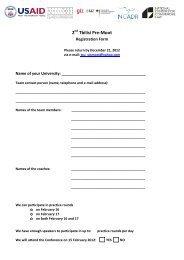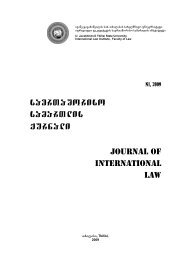Untitled
Untitled
Untitled
You also want an ePaper? Increase the reach of your titles
YUMPU automatically turns print PDFs into web optimized ePapers that Google loves.
N. KALANDADZE, INTERNATIONAL CONVENTION ON THE PROTECTION OF THE RIGHTS OF ALL ...<br />
norms. 66 International monitoring mechanisms<br />
including reporting and appealing procedures<br />
are only additional means for protection of the<br />
rights of labour migrants on domestic level. 67<br />
The principles promoted through the convention<br />
have nevertheless had an impact in<br />
specific countries and regions. In several receiving<br />
countries, anti-immigrant sentiments<br />
have decreased. 68 Practice reveals that there<br />
is a great difference between the establishment<br />
of standards and their implementation.<br />
International society named those fundamental<br />
rights and freedoms, which shall be guaranteed<br />
to everyone. Their operation on a State<br />
level depends on a State, while its implementation<br />
depends on an individual. On the way<br />
of implementation of human rights the most<br />
important issue which is also recognized by<br />
the UN is the education. It is directed to fundamental<br />
values of the society. Each citizen<br />
shall be aware of their rights.<br />
The situation in respect to Georgia is as<br />
follows: it is extremely difficult to find a job in<br />
Georgia, and incomes from employment are often<br />
not enough to secure one’s own and family’s<br />
subsistence. Limited employment possibilities,<br />
dysfunctional labour market dynamics<br />
and low wages, forces the most active part of<br />
the Georgian population to seek work and incomes<br />
outside the country, even if it results in<br />
reduction of their dignity and deprivation of<br />
their liberty. The planned reorganization and<br />
restructuring of the State management system<br />
resulted in a significant decrease in the<br />
number of employed.<br />
Current situation revealed the necessity<br />
to speed up accession process to the UN and<br />
ILO conventions that provide the international<br />
legal grounds for the regulation of labour<br />
migration. Among them particular attention<br />
shall be drawn to International “Convention on<br />
the Protection of the Rights of All Migrant Workers<br />
and Members of Their Families”. ILO and<br />
other international organizations shall ensure<br />
the assistance and provide recommendations<br />
of international experts on Governmental policy<br />
related to irregular migration and trafficking<br />
issues. The government, society and international<br />
community shall work and carry out<br />
activities in this field together.<br />
1<br />
Office of the United Nations High Commissioner for Human Rights, The international<br />
Convention on Migrant Workers and its Committee, Fact Sheet No. 24<br />
(Rev. 1), p.3 On the basis of the request of the economic and social council at<br />
1973 U.N. subcommittee on the prevention of discrimination and protection of<br />
minorities in 1976 adopted the act on the use of labour resulted from illegal and<br />
hidden trafficking. The mentioned act was calling for the UN to elaborate the<br />
Convention, which would protect the rights of the labour migrants. This particular<br />
recommendation was responded by the Geneva conference of 1978 on fighting<br />
against racism and racial treatment. But in the resolution 33/163 of the General<br />
Assembly was mentioned on improvement of the condition and ensuring the<br />
human rights protection and dignity of the labour migrants.<br />
2<br />
Please see: http://en.wikipedia.org/wiki/Human rights treaty_bodies, also Manfred<br />
Nowak, Introduction to the International Human Rights Regime, The Raoul Wallenberg<br />
Institute, Human Rights Library, Volume 14, Martinus Nijhoff Publishers,<br />
Leiden/Boston, 2003 and economic social and cultural rights, guideline second<br />
updated edition, Asborn Eide, Katerina Krauze, Alan Rosas, 2005, p. 456.<br />
3<br />
Economic, social and cultural rights, guidelines, second updated edition, Asborn<br />
Eide, Katerina Krauze, Alan Rosas, 2005, p. 456.<br />
4<br />
Office of the United Nations High Commissioner for Human Rights, The International<br />
Convention on Migrant Workers and its Committee, Fact Sheet No. 24<br />
(Rev.1), p. 1<br />
5<br />
Please see http://www.ohchr.org/english/countries/ ratification/13.htm, 2006.<br />
6<br />
http://en.wikipedia.org/wiki/Human_rights_treaty_ bodies,2C2006.<br />
7<br />
The convention consists of preamble and nine part: Preamble, 1. Scope and<br />
Definitions, 2. Non-discrimination with respect to rights, 3. Human rights of all<br />
Migrant Workers and Members of their Families, 4. Other Rights of Migrant Workers<br />
and Members of their Families who are Documented or in a Regular Situation,<br />
5. Provisions Applicable to Particular Categories of Migrant Workers and of<br />
their Families, 6. Promotion of Sound, Equitable, Humane and Lawful Condi-<br />
147



